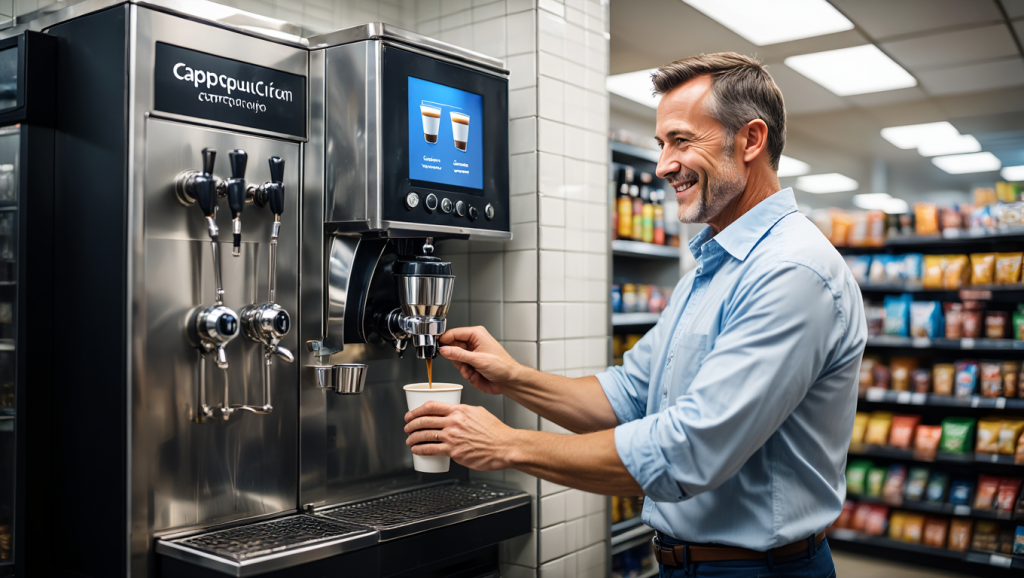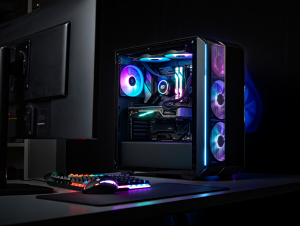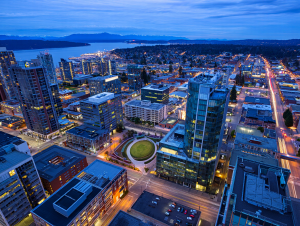
Across the United States, gas stations and corner stores are quietly becoming the frontlines of a new kind of coffee revolution. Instead of launching another chain of boutique cafés, a growing number of entrepreneurs and coffee brands are turning to a different strategy: installing self-serve espresso machines inside high-traffic retail locations.
This model, which prioritizes convenience, scalability, and operational efficiency, is rapidly proving to be one of the most cost-effective ways to build a national coffee brand. With machines capable of producing high-quality espresso drinks in under 30 seconds, and requiring little to no staff training, the economics are compelling for business owners and customers alike.
A Fast-Growing Market
The global self-service coffee machine market reached $6.47 billion in 2024 and is projected to grow to $7.12 billion in 2025, with forecasts suggesting it could exceed $10.3 billion by 2029. This growth is driven by consumer demand for quick, customizable, and high-quality beverages available in nontraditional settings. While the trend first gained traction in office buildings and hotels, convenience retailers are now capitalizing on the model’s efficiency and profitability.
For consumers, it’s about speed and convenience. For store owners and coffee brands, it’s about margins and scale. The average cost to produce a single espresso-based beverage in these machines is between $0.30 and $0.50, while the average retail price is around $2.75. That translates to gross margins of 60 to 80 percent—higher than most traditional cafés, which often operate with significantly more overhead.
Economics of a Self-Serve Coffee Machine
A mid-tier, fully automatic bean-to-cup espresso machine suitable for retail deployment costs approximately $5,000. These machines are designed to be low-maintenance and fully self-serve, with simple user interfaces and built-in cleaning cycles. Most require only occasional restocking and light servicing, which can be managed by a technician responsible for several hundred machines.
In a high-traffic location, a machine might serve 2,000 cups per month. At $2.75 per drink, that’s $5,500 in gross monthly revenue. Subtracting ingredient costs of roughly $800 per month, a single machine can yield a gross margin of $4,700. With those figures, the initial investment in the machine can be recouped in just over one month.
| Metric | Value |
| Machine Cost (CapEx) | $5,000 |
| Monthly Cups Sold | 2,000 |
| Average Price per Cup | $2.75 |
| Monthly Revenue | $5,500 |
| Monthly COGS (Ingredients) | $800 |
| Monthly Gross Margin | $4,700 |
| Payback Period on Machine | ~1.1 Months |
Scaling to a National Brand
To understand the national potential, consider a rollout of 10,000 machines across the country, installed in gas stations, convenience stores, and urban markets. At a $5,000 investment per machine, the total capital expenditure would be $50 million. However, the revenue potential is substantial.
Assuming each machine maintains similar performance to the pilot model—2,000 cups sold per month—the entire network could generate around $5.5 million in revenue daily, or approximately $6 billion annually (assuming 300 operating days). With a net margin of 20 percent, the operation would yield around $1.2 billion in annual profit, with break-even reached within two to three years.
The model is appealing because it avoids the labor, real estate, and utility costs associated with traditional cafés. There’s no need to manage baristas, pay rent on retail spaces, or navigate the complexities of full-service operations. The machines function as micro-outlets that can scale quickly and efficiently.
How the Rollout Might Work
A phased strategy would start with a pilot program: 100 machines in metro areas such as New York, Los Angeles, and Chicago, deployed through partnerships with national gas station and convenience store chains. Each machine would be co-branded—carrying both the national coffee brand and the store’s name—to establish local trust while building brand awareness.
Revenue-sharing agreements could incentivize store owners to participate without requiring them to front capital or manage operations. In this model, the coffee company retains ownership of the equipment and product, while the retail partner offers space and visibility in exchange for a percentage of sales or a flat monthly fee.
Advanced telemetry systems in each machine can monitor bean levels, maintenance status, and sales data in real time. Integration with mobile apps and loyalty platforms would enable digital payments, discounts, and push notifications, enhancing customer engagement.
Consumer and Retailer Benefits
For customers, the value proposition is clear: premium coffee, fast service, and a price well below that of boutique cafés. For retailers, the machines provide high-margin sales with minimal effort. The coffee brand benefits from rapid national growth, backed by performance data and without the drag of storefront operations.
A 2024 survey by Concordia Coffee found that gas stations and corner stores installing bean-to-cup espresso machines reported a 3x increase in coffee sales, along with improved customer satisfaction scores. Waste was reduced, inventory was easier to manage, and beverage consistency remained high.
| Store Type | Avg. Monthly Coffee Sales |
| Gas Station | $2,500 |
| Corner Store | $1,800 |
Challenges and Considerations
No model is without risks. Critics of the self-serve approach point to potential maintenance issues, inconsistent product quality, and the absence of ambiance or service experience. However, advancements in automation have largely addressed these concerns.
The use of sensors and cloud-based maintenance alerts ensures that most technical issues can be resolved before they impact sales. Ingredients are measured and sealed to maintain consistency, while the branding and machine design help create a premium perception.
Other common challenges, such as upfront capital or consumer hesitancy, can be mitigated through leasing models, demo campaigns, and localized marketing.
| Challenge | Mitigation Strategy |
| Upfront Equipment Costs | Leasing or revenue share with store owners |
| Maintenance Needs | IoT-enabled service teams and live diagnostics |
| Brand Recognition | Co-branding with trusted retail chains |
| Consumer Skepticism | Free sampling and in-store promotions |
The Road Ahead
If executed well, this model has the potential to transform the coffee retail landscape. Within one year, a pilot rollout could refine operations and branding. Over the following two to three years, the system could scale to thousands of machines. By year five, the brand could become a household name—not by opening cafés, but by meeting consumers where they already are.
Self-serve espresso offers a path to premium coffee that is frictionless, scalable, and profitable. It reflects broader trends in retail automation and on-the-go consumer behavior. As loyalty programs, AI-based sales forecasting, and mobile app integrations evolve, the business model will only become more sophisticated and effective.
Final Take
The vision of building a national coffee brand from behind the gas pump may once have sounded far-fetched. Today, it’s a smart bet. By combining automated precision, scalable infrastructure, and strong retail partnerships, self-serve espresso machines offer a low-cost, high-reward alternative to the traditional café model.
In a world where time is money, and convenience is king, this could be the most efficient way to win America’s caffeine habit—one corner store at a time.



